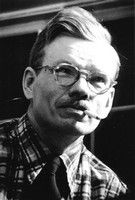Kenneth Stubbs |
 |
|
The Provincetown Art Association & Museum Features Paintings & Watercolors by Kenneth StubbsProvincetown, Massachusetts.- The Provincetown Art Association and Museum is proud to present "Kenneth Stubbs", an exhibition of the Modernist paintings and traditional watercolors of Kenneth Stubbs on display at the museum from October 7th through November 27th. There will be a free opening reception on Friday, October 7th from 7-9pm. From the early 1930s to his death in 1967, Kenneth Stubbs was immersed in the Provincetown arts community, having studied with E. Ambrose Webster in 1931 and in 1934. He showed regularly at the Provincetown Art Association and was a member of the Beachcomber's Club from 1938 - 1967. Additionally, he has had 15 one-man shows in the Washington, DC and Cape Cod areas. In a letter to art critic of The Washington Star, Florence Berryman, in January 1955, Stubbs wrote: "Some people ask what my objective is in painting. I prefer to think I have a position and a direction, rather than an objective. My position is based on a belief in the tradition of good painting as practiced by the Masters. My direction is based on the development and change that occur in my ideas about nature and life. To be more specific, I feel that the structure of my painting is based on tradition - while the content is based on ideas. Where these two things - tradition and idea - meet in the form of my painting, they become real. First of all, the forms are real to me. Where they also say something, so much the better. If a modern statement is the result, it is modern simply because my interests are modern. The fact that many of my paintings are concerned with flat or semi-flat patterns that depart more or less from the appearance of nature is simply a matter of style. This style comes from the need to have the entire painting, rather than the separate objects, express the idea. The fact that my watercolors and drawings are more nearly a reflection of nature is a matter of relaxed observation. I hope this statement will add something to the understanding of my work and my attitude toward art. As you know, artists always get into trouble when they write about their work. I hope that my paintings and drawings are better examples of my work than my written words are." The Provincetown Art Association and Museum (PAAM) was established in 1914 by prominent artists Charles Hawthorne, Oscar Gieberich, William Halsall, Gerrit Beneker, E. Ambrose Webster and several local business men and women. The donation of works by the organizing artists, and two juried exhibitions mounted in the summer of 1915, began PAAM's traditions of collecting and exhibiting the work of the local community of artists. By then, the art community at the tip of Cape Cod had become the refuge of artists and expatriates returned from war-torn Europe, and Provincetown was firmly established as "The Biggest Art Colony in the World." (Boston Globe, 8/8/16) PAAM consolidated its role as the anchor of that colony through the purchase and refurbishing of its present building in 1919. In the '20s and '30s, the philosophical wars being waged throughout the art world were also fought within the Association. Its artist founders had come out of the Impressionist tradition, and although a variety of styles had been represented in members' exhibitions since the inception, PAAM's "establishment" did not readily incorporate the modernist movement. Faced with aesthetic differences among its artist membership, PAAM maintained a balance. The Depression years of the '30s and the blacked-out war years of the early '40s were difficult times for the town and the Association. Although annual shows were canceled and the books at one point showed a balance of only $3.60, volunteers managed to maintain a reduced schedule. And by 1947, the regular schedule of two summer exhibitions had been reestablished. The rise of abstract expressionism--intensified by the location of Hans Hofmann's summer school here--again riffled the deep divisions within the arts community during the '50s. When PAAM celebrated its 50th anniversary in 1964 with a retrospective show of its major artists, the organization focused on gaining national attention for Provincetown's considerable contribution to American art. The effect was a boon for the organization. Activities increased, new galleries were added, the exhibition schedule expanded, a storage vault was built to house the expanding collection, and once again PAAM showed itself as the center of the local art world. The organization continued to grow throughout the next three decades, always adhering to its 1921 mission statement: to exhibit and collect art works of merit, and to educate the public in the arts. The dual purpose of the organization-to be a collecting museum and a professional artists' association-has been consistently supported over the course of its history. The collection has been the basis for many exhibitions and has served scholars, researchers and other museums. Including close to 2,000 works from artists who have lived or worked on the outer Cape, the collection is a burgeoning historical record of the art colony. PAAM continues to increase the number and range of works by earlier artists and to include works by contemporary artists. The artists' association has been a vital source of contemporary exhibitions; it also enables PAAM to employ the talents of working artists with exceptional ability as instructors of classes, workshops, lectures and demonstrations. PAAM's recent renovation and expansion has improved its facilities to reflect its mission. The contemporary wing--adjacent to the original building, which is listed on the National Register of Historic Places--enables artist members to show their work in contemporary galleries beside the significant American art collection and other world-class exhibitions. Visit the museum's website at ... https://www.paam.org Kerry Goodkind, Art Knowlege News website , September 24, 2011, pages 25 & 31
|
See also: Show Announcement Catalog Cape Cod Times Review Provincetown Banner Review Works Shown Installation Photos |